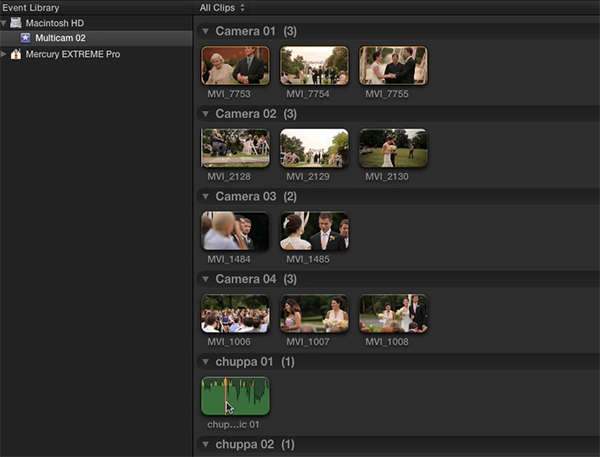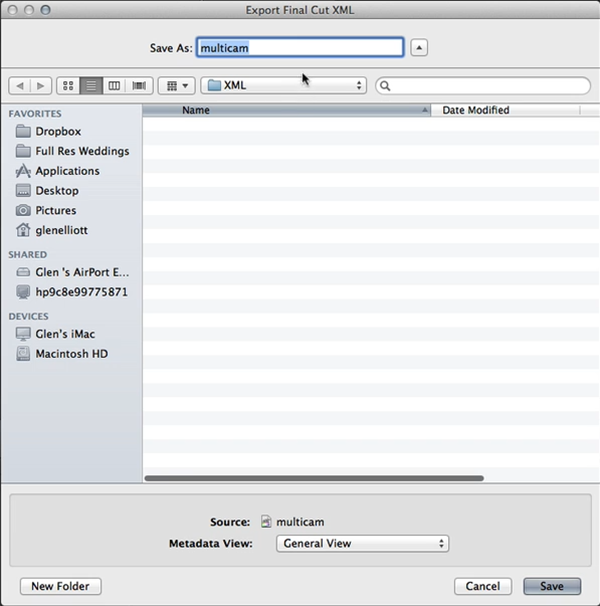Tutorial: Syncing Multicam Footage With PluralEyes 3
In part 2 of our series on multicam editing in Final Cut Pro X, 格伦·艾略特解释了如何在红巨人的PluralEyes 3中加速和简化多镜头同步过程.
By
格伦·艾略特
Posted on July 10, 2013
在本教程中,我们将继续讨论在Final Cut Pro X中的多镜头编辑. 在 在之前的教程中,我们讨论了如何在Final Cut Pro中本地同步您的素材, how to make a multi-clip, and how to edit it on the timeline.
In my own edits for Cord3Films, 我发现,当你有一个更复杂的项目时,Final Cut Pro基于波形同步素材的原生能力往往会变得有点棘手. 例如, 如果你有一个项目有多个角度,每个角度有多个开始和停止, 我们将在本教程中使用像这个项目这样的多个音频源, it tends to be a little less reliable.
For that reason, we always use an external source to sync our footage, and that’s a third-party program called PluralEyes, developed by Singular Software, acquired last year by Red Giant Software of Magic Bullet fame, and recently upgraded to v3. 我们将在本教程中探索如何在PluralEyes 3中同步您的FCP X素材.
Preparing the Footage
As you can see in 图1 (下图), we’ve begun preparing the footage by adding metadata to each camera, because when you bring it in to Final Cut Pro X, Final Cut Pro has no idea what camera it is. 所以我们添加了元数据来识别摄像头1,摄像头2,摄像头3,摄像头4. We’ve also done the same thing with our discrete audio sources, because each audio source has to be treated like its own angle, so we highlighted it, went into the Inspector, and added a camera name to all of our audio sources, our off-camera audio.

图1. Our footage, tagged and prepped for syncing
为了让PluralEyes 3同步你的素材,你需要做更多的准备. It’s essentially just making a project, dumping all of your footage in there, exporting the XML, and then bringing that into PluralEyes 3. PluralEyes 3是基于XML的同步,所以我们现在将带您了解整个过程.
To begin, we’ll open up a new project. 然后我们突出显示所有来自相机1的剪辑,并将它们附加到时间轴上. Next we do the same thing with Camera 2, 但我们必须把每个角度都堆叠起来——我们不希望它们并排. 它们必须是分开的,所以我们按下Q键,使Camera 2的镜头成为一个连接的剪辑(下面的图2).

图2. Stacking the clips
Each camera that has more than one file has to be grouped. 因此,下一步是突出显示来自相机2的文件(在本例中), 有3个。, and hit Command-G to group them, as shown in 图2. We’re going to do the same thing with Camera 3--hit Q, highlight the clips, press Command-G to group them--and the same for Camera 4, 诸如此类. Next we have to do that with all of our audio angles as well. They got staggered a little bit in the process, 所以我们只需要拖动它们以确保它们彼此堆叠在一起(图3), 下图).

图3. Camera angles connected and stacked.
现在我们已经拥有了导出XML所需的一切,这非常简单. You just choose File > Export XML (下面的图4) and name your file.

图4. Exporting the XML.
We’re going to name this one “multicam” (下面的图5).

图5. 命名文件.
Related 文章
以下是使用cineLook在FCP X中应用胶片纹理的两个工作流程(带和不带大猩猩纹理), first with 4k footage shot with the Blackmagic Production Camera, and then with Cinestyle-flattened DSLR footage.
In our first tutorial on the recently released FCP 10.1, we look at the new Libraries feature, 它增强了项目和媒体组织,并简化了从FCP 7过渡到编辑的调整.
这个Apple Final Cut Pro X教程详细介绍了检查器中的色彩校正, exploring the Balance Color, 颜色匹配, and Color Mask and Shape Mask features.
This tutorial on Apple Final Cut Pro X inspects the Video Inspector, FCP X界面的上下文敏感区域,允许您更改各种过滤器和设置的设置, and focuses on making basic but effective color adjustments.
在这个视频教程中,格伦·艾略特的Cord3Films着眼于FCP X的时间轴索引,它提供了创新的观看选项, 导航, and searching your projects, 包括三种不同类型的时间线标记,以及创建一个可导航的编辑笔记列表的能力,这对于协作工作流是必不可少的.
In this tutorial, Cord3Films的格伦·埃利奥特演示了如何在Apple Final Cut Pro X的多镜头编辑中混合来自多个摄像机外的音频.
我们的Final Cut Pro X教程系列继续在FCP X中进行多摄像机编辑的3部分系列的第一部分, 解决基础,如创建多镜头剪辑和切割和切换音频和视频使用角度编辑器.
在FCP X中使用复合剪辑类似于Final Cut Pro 7中的嵌套序列. Once you understand how it works, and how changes to compound clips can ripple across projects, 这是一个强大的功能,您会发现自己使用得越来越多.
In this tutorial, 我们将介绍几种方法,您可以使用连接的故事情节来增强您的FCP X编辑,并以快速有效的方式混合过场剪辑和创意镜头.
本教程探讨了FCP X中的高级编辑技术,包括反向编辑, replacing edits and auditioning, top-and-tail editing, 扩展编辑, trim-to-selection edits, keyboard trimming, and the Precision Editor.
磁性时间轴是Apple Final Cut Pro X的主要革命性变化之一, 这是编辑们从基于轨道的NLEs来的时候所遇到的困难之一. 在本教程中,我们将分解它并向您展示如何使其为您工作.
In this first installment of our new tutorial series, 格伦·艾略特 demystifies Final Cut Pro X, illustrates its core functions, 并专注于最强大的组织新功能之一, 加速, and streamlining your edits: metadata keyword tagging.